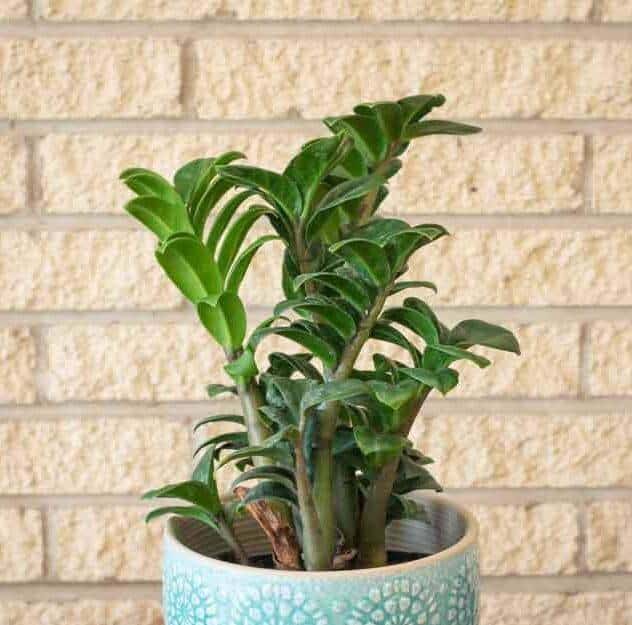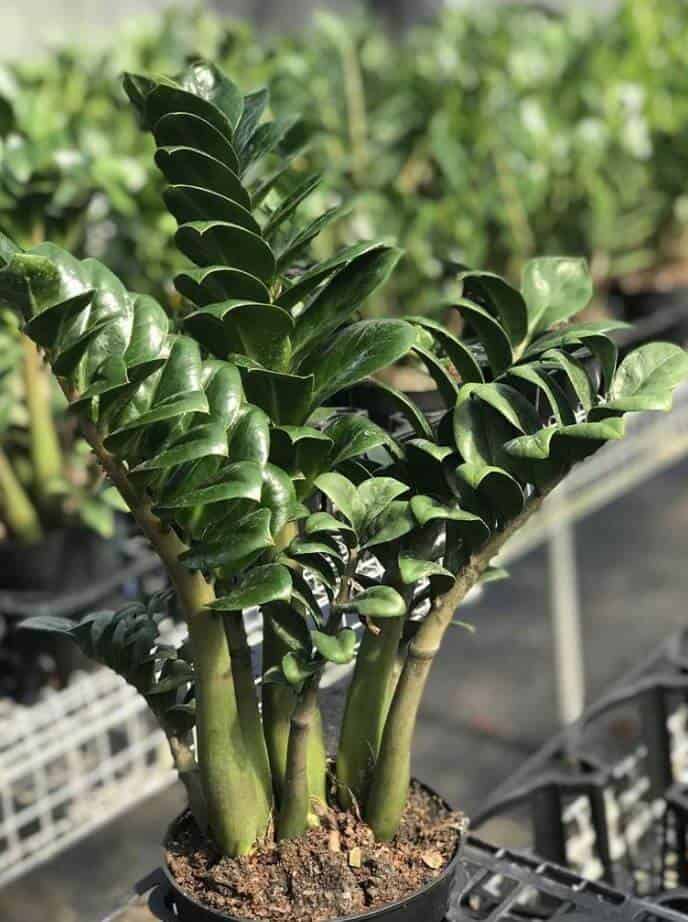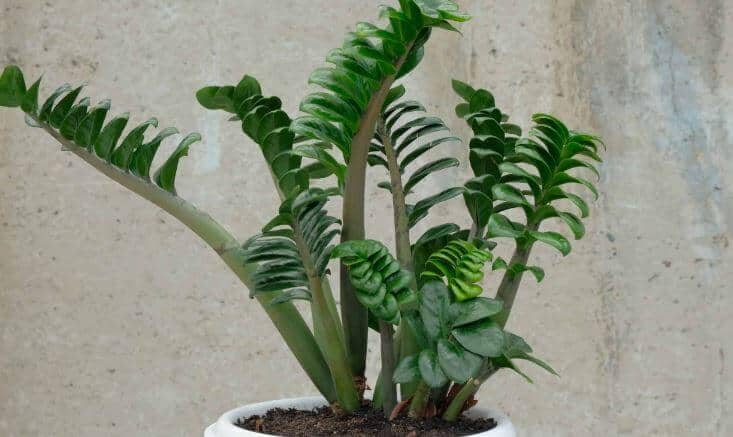Last Updated on September 9, 2023 by a Friendly Gardener
Recently, the Zenzi plant has increased in houseplant popularity leaving many to wonder if a Zenzi plant and a ZZ plant are the same thing. The Zenzi is a cultivar of the well-loved Zamioculcaszamiifolia plant affectionately called the “ZZ” plant.
The Zenzi cultivar was bred to be a more compact variety that is smaller in size, yet still boasts the beautiful foliage of the ZZ. As a smaller variety, the Zenzi plant is ideal for less spacious spots or as an office plant. Like the ZZ, the Zenzi is incredibly easy to take care of. While they are two different plants, they belong to the Araceae family and require similar environmental conditions to thrive.
Botanically identified as the Zamioculcas Zamiifolia ‘Zenzi’, this plant cultivar will reach approximately a foot in height at maturity compared to the ZZ’s potential three feet. Dense foliage is comprised of curled-tip, darker leaflets. Like other ZZ species, the Zenzi is born of a group of plants native to east Africa where climate conditions are arid desert-like. As a result, they have developed drought tolerance and require little watering thanks to a rhizome root system that stores water for the plant under the soil surface.
These plants tend to have a slow growth rate, but they also can live for generations.
Zenzi ZZ Plant Care

Ideal for beginner gardeners that do nth ae a propensity for overwatering, Zenzi plants need to be treated like succulents. Due to their need for hotter climate temperatures, they are generally cultivated as indoor houseplants.
Soil

Good Zenzi care requires dry, loose soil. The greatest risk to these cultivars is overwatering. The zenzi needs a growing medium that provides excellent aeration to root systems and encourages excess water drainage. Select a cactus or succulent potting soil formula with a pH that is neutral to acidic. You can also add in extra pumice or perlite to retain minimal moisture in the soil. Containers must be well-draining with a sufficient number of drainage holes. Clay or terracotta pots will aid in wicking away excess moisture. Avoid selecting a pot that is much larger than the plant’s root system, as this will require added soil, which in turn will retain more water and increases the risk for root rot.
Light

One of the winning aspects of ZZ cultivars for indoor gardens is that they adapt very well to low-light conditions. They can receive some direct sunlight exposure from a window source, but exposure should be limited to three hours. Otherwise, they do exceptionally well when supplied with bright indirect natural light in the vicinity of a window or when partially shielded by other houseplants. Thinning foliage or considerable space between leaflets indicates insufficient light.
Water
The Zenzi plant, like its ZZ relations, is very drought tolerant and prefers dry soil to soggy soil. It is easier for this plant to manage and survive in dry soil than in wet soil. When a Zenzi is overwatered, it will cease to absorb the excess water it does not require leaving it to sit in soggy soil. This creates the perfect conditions for fungal infections to develop. Before you water your Zenzi, the soil bed should be dry to at least half of its depth.
Humidity

The Zenzi plant does not require humidity, so it will be fine if your indoor air is on the dry side.
Temperature
The ZZ Zenzi does fine in indoor temperatures measuring between 60° and 75° F., or higher. They should not be exposed to temperatures lower than 45°F.
Feeding
During the growing season, this ZZ cousin will benefit from some nutrient boost. Select a liquid fertilizer formulated for succulents or cacti and apply it monthly after you have watered. To be on the safe side, dilute your fertilizer to half of the recommended strength.
Repotting a Zenzi Plant

This plant only requires repotting if it has outgrown its current pot. If you notice the plant’s rhizomes pressing up through the soil or against the container sides, it’s time to repot. These plants will suffer if they become rootbound. Plan to repot in spring or summer when the plant is in its growing season. Choose a pot with adequate drainage holes that are only one size larger than the present container.
ZZ Zenzi Propagation
A Zenzi can be easily propagated using several methods:
-
Root system division
This is the simplest method for propagation. Remove the plant from its pot and divide the root system, placing each new section in individual containers. Zenzi root systems include thick rhizomes, so take care not to damage your plant.
-
Stem cuttings
Remove an entire stem from a healthy plant and place it in a jar or glass vase or water. Change the water every 5 to 7 days to prevent bacterial growth. When roots develop (probably after a few months) they can be transplanted into a smallish container with soil mix. Be patient as your new plant may need months to develop new growth.
-
Leaf cuttings
Trim several leaves off your plant and set them aside for a day or two to callous. Place a third of the trimmed leaves into one part succulent soil mix and one part perlite. Water sparingly and place in a warm spot with ample bright indirect sunlight. Water when the soil mix feels dry.
The warmer the environmental conditions, the more quickly propagation will proceed. After approximately a month inspect your stem or leaf cuttings for root and rhizome development.
ZZ Zenzi Problems
Yellowing foliage indicates that the soil bed is overly wet which can develop into root rot. In this case, remove your plant from its container and repot it in a fresh dry soil mix. Examine the root system for infection and remove compromised roots. Leaf drop with yellowing foliage usually indicates underwatering and dehydration.
ZZ Zenzis are generally free of infections and disease but do examine your plant for signs of pests. Aphids, scale, fungus gnats, and mealybugs enjoy a home in these plants. If you notice evidence of a pest infestation, remove pests manually and treat them with insecticidal soap.
ZZ Zenzi Toxicity
Unfortunately, the ZZ Zenzi is toxic to family pets due to its containing calcium oxalate crystals. Crystals will irritate the digestive tract and mouth if ingested. If you suspect ingestion, watch for drooling, difficulty breathing, or vomiting. Call a veterinarian immediately.
Common calcium oxalate poisoning signs can include:
- Mouth discomfort
- Difficulty swallowing
- Drooling
- Foaming at the mouth
- Pawing at the mouth
- Mouth, lips, tongue, or eye irritation
- Difficulty breathing
- Vomiting
- Loss of appetite
- Tremors
- Diarrhea

